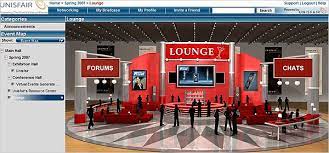The Rise of Virtual Trade Shows: A New Era in Networking and Business
In recent years, the concept of a traditional trade show has undergone a significant transformation with the emergence of virtual trade shows. As technology continues to advance, businesses are embracing these innovative platforms to connect with potential customers, showcase their products or services, and foster valuable networking opportunities.
So, what exactly is a virtual trade show? In essence, it is an online event that replicates many aspects of a physical trade show in a digital environment. Participants can attend from anywhere in the world using their computers or mobile devices, eliminating the need for travel expenses and geographical limitations.
One of the key advantages of virtual trade shows is their accessibility. Traditional trade shows often require significant investments in terms of time, money, and resources. However, virtual trade shows offer a cost-effective alternative that allows businesses of all sizes to participate without breaking the bank.
Moreover, attending a virtual trade show provides attendees with greater flexibility. Participants can access the event at any time during its duration and explore exhibitor booths, watch product demonstrations or presentations, engage in live chats with company representatives or fellow attendees – all from the comfort of their own homes or offices.
Virtual trade shows also enable businesses to collect valuable data and insights. Through analytics tools embedded within these platforms, companies can track attendee engagement levels, measure booth traffic and visitor interactions, and gather feedback for future improvements. This data-driven approach empowers businesses to make informed decisions about their marketing strategies and optimize their online presence.
Another noteworthy aspect of virtual trade shows is their potential for global reach. With physical events limited by geographical constraints, expanding one’s network internationally can be challenging. However, virtual trade shows break down these barriers by connecting businesses from around the globe on a single platform. This opens up doors to new markets, collaborations, and partnerships that were previously unimaginable.
Of course, virtual trade shows cannot fully replicate the sensory experience of a physical event. The buzz of a crowded exhibition hall, the face-to-face interactions, and the tactile engagement with products are elements that are difficult to replicate in a digital environment. However, virtual trade shows offer their own unique advantages that make them an increasingly popular choice for businesses seeking to adapt to the changing landscape.
As technology continues to evolve, we can expect virtual trade shows to become even more immersive and interactive. With the integration of augmented reality (AR) and virtual reality (VR) technologies, participants may soon be able to explore virtual showrooms, interact with lifelike avatars representing exhibitors or attendees, and even attend live presentations or workshops in a simulated environment.
In conclusion, virtual trade shows have emerged as a game-changer in the world of networking and business exhibitions. They provide an accessible, cost-effective, and flexible platform for businesses to connect with their target audience on a global scale. As technology advances further, we can anticipate even more exciting developments in this rapidly growing industry.
9 Essential Tips for Maximizing Success at Your Next Virtual Tradeshow
- Choose a reliable virtual tradeshow platform that suits your needs.
- Create an engaging virtual booth with interactive elements like videos, product demos, and downloadable resources.
- Promote your participation in the virtual tradeshow through email campaigns and social media posts.
- Offer exclusive discounts or promotions to attendees who visit your virtual booth.
- Make sure to have live chat support available to answer attendee questions in real-time.
- Prepare compelling presentations or webinars to showcase your products or services during the tradeshow.
- Collect attendee data for lead generation by offering incentives like free e-books or access to industry reports.
- Follow up with leads promptly after the tradeshow ends to nurture potential customers and convert them into sales.
- Analyze the data and feedback gathered from the virtual tradeshow to improve future participation.
Choose a reliable virtual tradeshow platform that suits your needs.
When planning to participate in a virtual trade show, it is crucial to choose a reliable platform that aligns with your specific needs. Selecting the right virtual trade show platform can make a significant difference in the success of your online exhibition. Look for a platform that offers robust features such as interactive virtual booths, seamless video conferencing capabilities, and user-friendly navigation. Consider factors like customization options, attendee engagement tools, and analytics capabilities to ensure you can effectively showcase your products or services and connect with potential customers. By carefully evaluating and selecting a reliable virtual trade show platform, you can maximize your online presence and make the most out of your virtual trade show experience.
Create an engaging virtual booth with interactive elements like videos, product demos, and downloadable resources.
To make the most of your virtual trade show experience, it is crucial to create an engaging virtual booth that captures the attention of attendees. Incorporating interactive elements such as videos, product demos, and downloadable resources can significantly enhance the overall impact of your booth. Videos allow you to showcase your products or services in action, providing a dynamic and immersive experience for visitors. Product demos enable potential customers to see firsthand how your offerings can meet their needs and solve their challenges. Additionally, offering downloadable resources like brochures, whitepapers, or case studies provides valuable information that attendees can take with them and refer back to later. By incorporating these interactive elements into your virtual booth, you can effectively engage with visitors, leave a lasting impression, and generate meaningful leads.
Promote your participation in the virtual tradeshow through email campaigns and social media posts.
To maximize the impact of your participation in a virtual tradeshow, it is crucial to promote your involvement through strategic email campaigns and engaging social media posts. By leveraging these digital channels, you can generate buzz and excitement among your existing audience while also reaching potential customers who may be interested in your offerings. Craft compelling emails that highlight the value and unique aspects of the virtual tradeshow, such as exclusive deals or sneak peeks at new products. Additionally, create attention-grabbing social media posts that showcase your booth, share informative content related to the event, and encourage followers to visit your virtual space. Remember to include relevant hashtags and tag the event organizers to increase visibility. With effective promotion through email campaigns and social media posts, you can drive traffic to your virtual booth and make a lasting impression on attendees.
Offer exclusive discounts or promotions to attendees who visit your virtual booth.
When participating in a virtual trade show, one effective tip to attract and engage attendees is to offer exclusive discounts or promotions. By providing special offers that are only available to those who visit your virtual booth, you create a sense of exclusivity and incentive for attendees to interact with your brand. These exclusive discounts can be in the form of limited-time promotions, discounted pricing, bundle deals, or even freebies. Not only does this strategy encourage attendees to explore your booth and learn more about your products or services, but it also helps drive conversions and generate leads. Offering exclusive discounts or promotions is an excellent way to make your virtual booth stand out from the competition and leave a lasting impression on potential customers.
Make sure to have live chat support available to answer attendee questions in real-time.
When participating in a virtual trade show, it is crucial to have live chat support available to answer attendee questions in real-time. This feature allows exhibitors to provide immediate assistance and engage with potential customers, enhancing their overall experience. By offering live chat support, businesses can address inquiries promptly, provide detailed information about their products or services, and establish a personal connection with attendees. This interactive approach not only builds trust and credibility but also increases the chances of converting leads into valuable business opportunities.
Prepare compelling presentations or webinars to showcase your products or services during the tradeshow.
During a virtual trade show, it is crucial to prepare compelling presentations or webinars to effectively showcase your products or services. With attendees unable to physically interact with your offerings, it becomes essential to captivate their attention through engaging content. Craft informative and visually appealing presentations that highlight the unique features and benefits of your products or services. Incorporate multimedia elements such as videos, images, and interactive demos to provide a comprehensive understanding of what you have to offer. By delivering compelling presentations or webinars, you can effectively convey the value of your offerings and leave a lasting impression on attendees, ultimately driving interest and potential business opportunities.
Collect attendee data for lead generation by offering incentives like free e-books or access to industry reports.
In the realm of virtual trade shows, one effective tip for lead generation is to collect attendee data by offering enticing incentives such as free e-books or access to industry reports. By providing valuable resources, businesses can encourage attendees to share their contact information, allowing for future follow-ups and nurturing potential leads. This strategy not only helps in building a database of interested prospects but also establishes credibility and positions the company as a trusted source within the industry. By leveraging these incentives, businesses can maximize their virtual trade show experience and generate meaningful connections that may translate into fruitful business opportunities.
Follow up with leads promptly after the tradeshow ends to nurture potential customers and convert them into sales.
One crucial tip for virtual trade shows is to follow up with leads promptly after the event concludes. The digital environment may make it easier to collect leads, but timely and personalized follow-ups are still essential for nurturing potential customers and converting them into sales. By reaching out to leads shortly after the tradeshow ends, businesses can demonstrate their attentiveness and commitment, keeping their brand top-of-mind and building a stronger relationship. Whether it’s through personalized emails, phone calls, or virtual meetings, prompt follow-up communication shows professionalism and can significantly increase the chances of converting leads into valuable customers.
Analyze the data and feedback gathered from the virtual tradeshow to improve future participation.
Analyzing the data and feedback gathered from a virtual trade show is crucial for improving future participation. By carefully examining attendee engagement levels, booth traffic, visitor interactions, and feedback received, businesses can gain valuable insights into their performance and identify areas for improvement. This data-driven approach enables companies to refine their marketing strategies, optimize their virtual presence, and enhance the overall experience they offer to attendees. By leveraging the information obtained from each virtual trade show, businesses can continuously adapt and evolve their approach, ensuring that future participations are even more successful and impactful.


